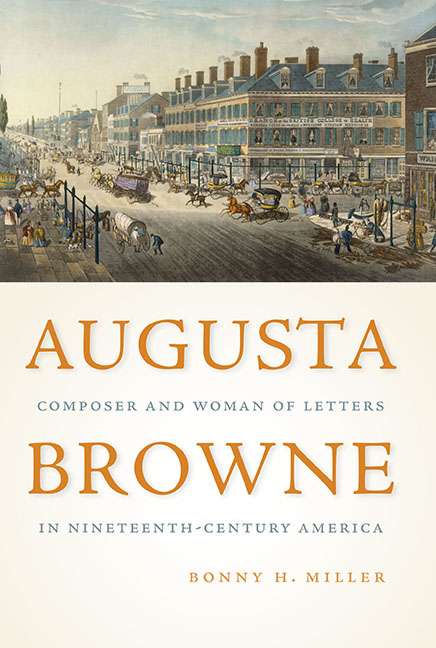Book contents
- Frontmatter
- Contents
- List of Illustrations
- Preface
- Acknowledgments
- Introduction
- 1 First Steps
- 2 Apprentice in a Family Music Business
- 3 Philadelphia Debut
- 4 A Young Professor of Music
- 5 A New Leaf
- 6 Her Own Woman
- 7 Courtship and Consequences
- 8 Pilgrim in Progress
- 9 “Glad Fruition”
- 10 Legacy in Music
- 11 Legacy in Literature
- 12 Contributions to Music Journalism
- 13 A Legacy Written into History
- Appendixes
- Appendixe 1 Children and Descendants of David Samuel Browne and Elizabeth Montgomery Browne
- Appendixe 2 Chronology of Augusta Browne’s Music and Letters
- Appendixe 3 List of Musical Works
- Appendix 4 Selected Glossary
- List of Abbreviations
- Notes
- Selected Bibliography
- Index
- Frontmatter
- Contents
- List of Illustrations
- Preface
- Acknowledgments
- Introduction
- 1 First Steps
- 2 Apprentice in a Family Music Business
- 3 Philadelphia Debut
- 4 A Young Professor of Music
- 5 A New Leaf
- 6 Her Own Woman
- 7 Courtship and Consequences
- 8 Pilgrim in Progress
- 9 “Glad Fruition”
- 10 Legacy in Music
- 11 Legacy in Literature
- 12 Contributions to Music Journalism
- 13 A Legacy Written into History
- Appendixes
- Appendixe 1 Children and Descendants of David Samuel Browne and Elizabeth Montgomery Browne
- Appendixe 2 Chronology of Augusta Browne’s Music and Letters
- Appendixe 3 List of Musical Works
- Appendix 4 Selected Glossary
- List of Abbreviations
- Notes
- Selected Bibliography
- Index
Summary
In New York City advertisements during the 1840s, Augusta Browne usually described herself as a “Composer and Professor of Music,” and her sheet music covers often identified her as “Professor of the Theory and Practice of Music.” By 1845 she had the reputation and name recognition to identify herself simply as “Miss Augusta Browne” and increasingly she dropped the “Miss.” By the end of the decade, she was her own woman and an independent musician, no longer in any business partnership with her father. As Augusta entered her thirties, she had eluded such familiar tropes as the amateur “piano girl” in the typical middle-class home, the artistic muse of a (more) talented man, or the financial patron of other musicians. She enjoyed professional connections, a social circle of friends in the arts, and plenty of publications in music and prose. Augusta received national recognition in 1854 in the Lady's Almanac as one of America's outstanding female authors. Eighty years before the British author Virginia Woolf declared that “a woman must have money and a room of her own if she is to write,” Augusta was earning an income and had a room of her own, even if—like Emily Dickinson—it was in her parent's residence. While her income would have supported living on her own in some manner, she chose not to leave the family home.
Her younger sibling William Henry Browne was not quite twenty-one in May 1846, when the dispute between the United States and Mexico became a formal conflict. In December he signed up for service in the New York Volunteers as a second lieutenant. He departed for the battlefield with a send-off from Augusta entitled the Mexican Volunteers Quickstep, which was applauded in the local papers with the plug, “We advise all our female readers to purchase this and see how sweet a tribute a patriotic sister can render to a gallant and beloved brother.” This lively piece was a note-for-note duplication of her Columbian Quick-Step with an updated title, but it made a splash in the Brooklyn papers as “brilliant, yet easy” and “spirited.”
- Type
- Chapter
- Information
- Augusta BrowneComposer and Woman of Letters in Nineteenth-Century America, pp. 116 - 143Publisher: Boydell & BrewerPrint publication year: 2020

